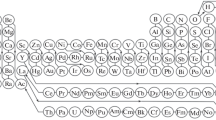Abstract
The mineral frequency distribution of Earth’s crust provides a mineralogy-based statistical measure for characterizing Earth-like planets. It has previously been shown that this distribution conforms to a generalized inverse Gauss–Poisson large number of rare events model. However, there is no known analytic expression for the probability distribution of this model; therefore, the population probabilities do not exist in closed forms. Consequently, in this paper, the population probabilities are calculated numerically for all mineral species in Earth’s crust, including the predicted undiscovered species. These population probabilities provide an estimate of the occurrence probabilities of species in a random sample of N mineral species–locality pairs. These estimates are used to characterize Earth in terms of its mineralogy. The study demonstrates that Earth is mineralogically unique in the cosmos. In spite of this uniqueness, the frequency distribution of minerals from Earth can be used to quantify the extent to which another planet is Earth-like. Quantitative criteria for characterizing Earth-like planets are given. An example, involving mineral species found on Mars by the CheMin instrument during the Mars Science Laboratory mission suggests that Mars is mineralogically similar to an Earth-like planet.







Similar content being viewed by others
References
Baayen RH (2001) Word frequency distributions, text, speech and language technology, vol 18. Kluwer Academic Publishers, Dordrecht
Borucki W, Koch D, Batalha N, Caldwell D, Christensen-Dalsgaard J, Cochran WD, Dunham E, Gautier TN, Geary J, Gilliland R, Jenkins J, Kjeldsen H, Lissauer JJ, Rowe J (2008) Kepler: search for Earth-size planets in the habitable zone. Proc Int Astron Union 4:289–299
Borucki WJ, Koch DG, Basri GB, Caldwell DA, Caldwell JF, Cochran WD, DeVore E, Dunham EW, Geary JC, Gilliland RL, Gould A, Jenkins JM, Kondo Y, Latham DW, Lissauer JJ (2003) The Kepler mission: finding the sizes, orbits and frequencies of Earth-size and larger extrasolar planets. In: Deming D, Seager S (eds) Scientific frontiers in research on extrasolar planets, ASP conference series, vol 294, pp 427–440
Donahoe FJ (1966) On the abundance of Earth-like planets. Icarus 5:303–304
Downs RT (2015) Determining mineralogy on Mars with the CheMin X-ray diffractometer. Elements 11:45–50
Evert S (2004) A simple LNRE model for random character sequences. In: Proceedings of the 7èmes Journées Internationales d’Analyse Statistique des Données Textuelles, Louvain-la-Neuve, Belgium, pp 411–422
Evert S, Baroni M (2007) zipfR: word frequency distributions in R. In: Proceedings of the 45th annual meeting of the association for computational linguistics, Prague, Czech Republic, Posters and Demonstrations Session, pp 29–32
Evert S, Baroni M (2008) Statistical models for word frequency distributions, package zipfR. http://zipfr.r-forge.r-project.org/materials/zipfR_0.6-5.pdf. Accessed 1 June 2015
Grew ES, Hazen RM (2014) Beryllium mineral evolution. Am Miner 99:999–1021
Hazen RM, Papineau D, Bleeker W, Downs RT, Ferry JM, McCoy TJ, Sverjensky DA, Yang H (2008) Mineral evolution. Am Miner 93:1693–1720
Hazen RM, Bekker A, Bish DL, Bleeker W, Downs RT, Farquhar J, Ferry JM, Grew ES, Knoll AH, Papineau D, Ralph JP, Sverjensky DA, Valley JW (2011) Needs and opportunities in mineral evolution research. Am Miner 96:953–963
Hazen RM, Grew ES, Downs RT, Golden JJ, Hystad G (2015a) Mineral ecology: chance and necessity in the mineral diversity of terrestrial planets. Can Miner 00:1–29
Hazen RM, Hystad G, Downs RT, Golden JJ, Pires AJ, Grew ES (2015b) Earth’s ‘missing’ minerals. Am Miner 100:2344–2347
Hystad G, Downs RT, Grew ES, Hazen RM (2015a) Statistical analysis of mineral diversity and distribution: Earth’s mineralogy is unique. Earth Planet Sci Lett 426:154–157
Hystad G, Downs RT, Hazen RM (2015b) Mineral species fequency distribution conforms to a large number of rare events model: prediction of Earth’s missing minerals. Math Geosci 47:647–661
Johnson RA, Wichern DW (2007) Applied multivariate statistical analysis, 6th edn. Pearson, Upper Saddle River
Ryaben’kii VS, Tsynkov SV (2006) A theoretical introduction to numerical analysis. Chapman & Hall/CRC, Boca Raton
Seager S (2003) The search for extrasolar Earth-like planets. Earth Planet Sci Lett 208:113–124
Shen TJ, Chao A, Lin CF (2003) Predicting the number of new species in further taxonomic sampling. Ecology 84(3):798–804
Sichel HS (1971) On a family of discrete distributions particularly suited to represent long-tailed frequency data. In: Proceedings of the third symposium on mathematical statistics, Pretoria, South Africa, pp 51–97
Sichel HS (1975) On a distribution law for word frequencies. J Am Stat Assoc 70:542–547
Sichel HS (1986) Word frequency distributions and type-token characteristics. Math Sci 11:45–72
Ward PD, Brownlee D (2003) Rare Earth: why complex life is uncommon in the universe. Copernicus, New York
Williams RE, Blacker B, Dickinson M, Dixon WVD, Ferguson HC, Fruchter AS, Giavalisco M, Gilliland RL, Heyer I, Katsanis R, Levay Z, Lucas RA, McElroy DB, Petro L, Postman M, Adorf HM, Hook R (1996) The Hubble deep field: observations, data reduction, and galaxy photometry. Astron J 112:1335
Acknowledgements
Two anonymous reviewers provided detailed and valuable suggestions for improving the manuscript. We received critical advice and data from Edward Grew. We gratefully acknowledge support from NASA Mars Science Laboratory Mission NNX11AP82A, as well as support from the Alfred P. Sloan Foundation (Grant Number 2013-10-01), the W. M. Keck Foundation (Grant Number 140002372), the Deep Carbon Observatory, the Carnegie Institution for Science, and an anonymous private foundation.
Author information
Authors and Affiliations
Corresponding author
Rights and permissions
About this article
Cite this article
Hystad, G., Downs, R.T., Hazen, R.M. et al. Relative Abundances of Mineral Species: A Statistical Measure to Characterize Earth-like Planets Based on Earth’s Mineralogy. Math Geosci 49, 179–194 (2017). https://doi.org/10.1007/s11004-016-9661-y
Received:
Accepted:
Published:
Issue Date:
DOI: https://doi.org/10.1007/s11004-016-9661-y




